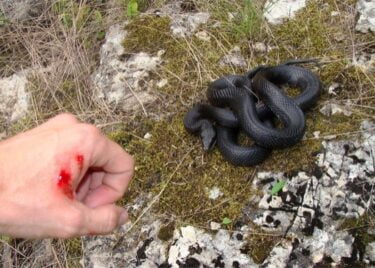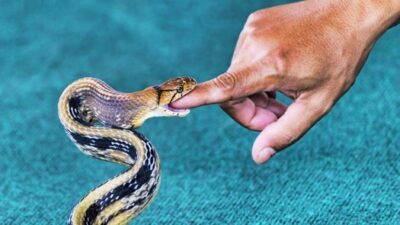While snakes do become more trusting of their owners over time, they can’t ‘love’ or ‘feel affection’ for you. This means that there’s always going to be a chance that a snake could become defensive and bite you.
Snakes are obligate carnivores that are fearful of larger animals that they don’t know, so they all share the same striking instinct. Snakes can only defend themselves with their sharp teeth and fangs, but you’re less likely to get bitten once a snake learns that it can trust you. The scent that you give off will begin to have positive associations.
We will explain more about snakes that don’t bite as often as others. These snakes will still have defensive instincts, and can bite if provoked/unsettled, but they are more docile and tolerant of humans than other species.
Why Do Snakes Bite People?
If your snake bites you, it will be due to fear, hunger, or irritation. When scared, some snakes will get defensive and strike or feign strikes at you.
- When hungry, a snake might start striking at things it thinks are food, which will likely include your hands.
- A snake could also lose patience with you because it’s just eaten or is shedding its skin, and tell you to stop in the only way it knows how.
- If you have mistreated your snake in the past, it will remember. A snake will associate your smell/odor will danger.
Venomous snakes are slow to release their bite. That’s why you shouldn’t keep a rattlesnake or any other snake with venom glands as a pet.
Here are the main reasons why snakes bite humans.
Which Pet Snake Is Least Likely to Bite?
So, what is the least aggressive snake? There are snakes with ‘alternative’ defense mechanisms that they use in preference to biting you. Other types of snakes seem to have more relaxed temperaments around humans.
Ball Python
What’s the most harmless pet snake? It could well be the ball python. Their popularity is in no small part because they’re docile nature. But, why are ball pythons less likely to bite you than other snakes?
When threatened, the ball python lives up to its name by curling up into as small a ball as possible. It wraps itself tightly in its coils and tucks its head and neck away so that any threats can’t reach its most vulnerable areas.
This defense mechanism is unique to ball pythons. It’s a much ‘safer’ alternative to other snakes, which will coil up into an S-shape and get ready to strike when they feel threatened.Kenyan Sand Boa

Kenyan sand boas are less common pets than ball pythons and corn snakes. They’re non-venomous, easy-going, and less likely to nip humans. Sensible handling rarely leads to aggression or bites.
The species doesn’t have a volatile temperament, but each snake has a unique personality. You’re most likely to get bitten by a Kenyan sand boa as a feeding response, so feed your snake its meal with tongs.
Pick your snake up from the center of its body as it has a heavy middle to provide additional support. Always approach the snake from a position that it can detect your scent and determine that you’re not a threat.
Western Hognose Snake
Western hognose snakes are placid and docile, rarely ever trying to bite their owners. They use an alternative defense system to other snakes.
When threatened, a Western hognose will play dead by rolling over onto its back and lolling out its tongue. If you try and flip it back upright, it’ll roll over again as if insisting that it’s really dead.
Hognose snakes have a mild venom, but it’s only enough to kill the small frogs, lizards, and rodents that they feed on in the wild. If you’re bitten by a hognose, it might hurt and become slightly inflamed at worst.
Hognose snakes stay small. Because of their diminutive size, even if they do bite, they won’t do you any lasting damage.
Rosy Boa
If you’re looking for snakes that aren’t ‘poisonous’ and don’t bite, you can’t go wrong with a rosy boa. Rosies don’t grow long, are easy to care for, and are one of the slowest snakes. They’re good pet snakes for beginners.
Like Kenyan sand boas, rosy boas are ambush hunters. This means that they burrow under sand and wait for prey to come to them. If you disturb a rosy boa when they’re in ambush mode, then they might try and strike you, because you elicit their feeding response.
But if you’re a little wiser, you’ll wait until they’re not in ‘feeding’ mode before handling. And, if you do, you’re unlikely to get bitten. Rosy boas are docile and gentle snakes when you handle them.

California Kingsnake
California kingsnakes (royals) are flighty and nervous when young. All colubrids—including corn snakes and garter snakes—are the same.
When they’re adults, these constrictor snakes are docile and won’t get aggressive with humans unless you really annoy and aggravate them.
As juveniles, you can forgive their behavior. They’re so small that you can understand why being approached by something as large as a human can make them nervous. But with regular handling and maturity, California kingsnakes grow into one the calmest and most gentle snakes out there.
Remember that colubrids become the product of your treatment. If you treat your snake with respect and handle them carefully, but confidently, they’ll grow up to be calm and confident snakes.
But if you pick up your California kingsnake up when it’s unhappy, hit it, or aggravate it, of course, it will learn to defend itself out of fear.
Do Pet Snake Bites Hurt?
The pain of the bite depends on the snake. For the vast majority of snakes, the bite isn’t going to hurt any more than a cat’s warning bite. It’s more of a shock than anything. If you’re bitten a few times, you get used to it.
The snakes that most people have as pets are small colubrids like corn snakes, which have rear-facing teeth. These rear-facing teeth latch onto prey but aren’t very long—a quarter of an inch at most in most snakes.

If a colubrid with rear-facing teeth bites onto you, don’t try and pull it off, because that will make its teeth sink deeper. Instead, hold it fairly firmly behind the head and push down, towards your hand. That way, its teeth will slide right out of the bite.
Safe Snake Handling Practices
- Don’t pick up a snake that doesn’t want to be picked up. Forcing a snake to do something, whether you’re feeding or handling it, will cause the snake to dislike you.
- When you go to pick up a snake, move quietly and confidently in the snake’s line of sight. Don’t hesitate, shake, or act nervously. If you show signs of nerves, your snake will also feel nervous.
- If you’re handling a constrictor, expect them to coil around your fingers. If they coil too tight somewhere that they shouldn’t, you can unwrap them from their tail end.
- Don’t pick a snake up or move them around too quickly. Move at a pace that your snake is comfortable with.
- Wash your hands each time that you handle prey. The last thing that you want is for your hands and fingers to smell like the snake’s meal.
- Don’t handle a snake after its eaten or during the shedding process.
If you choose the right constrictor snake and follow the above guidelines, then it’s far less likely that your snake will bite you.

